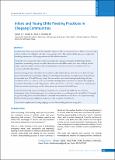Please use this identifier to cite or link to this item:
https://hdl.handle.net/20.500.14356/1926Full metadata record
| DC Field | Value | Language |
|---|---|---|
| dc.contributor.author | Subedi, N | - |
| dc.contributor.author | Paudel, S | - |
| dc.contributor.author | Rana, T | - |
| dc.contributor.author | Poudyal, A K | - |
| dc.date.accessioned | 2023-06-01T10:43:43Z | - |
| dc.date.available | 2023-06-01T10:43:43Z | - |
| dc.date.issued | 2012 | - |
| dc.identifier.citation | SubediN., PaudelS., RanaT., & PoudyalA. K. (2012). Infant and Young Child Feeding Practices in Chepang Communities. Journal of Nepal Health Research Council. https://doi.org/10.33314/jnhrc.v0i0.323 | en_US |
| dc.identifier.issn | Print ISSN: 1727-5482; Online ISSN: 1999-6217 | - |
| dc.identifier.uri | http://103.69.126.140:8080/handle/20.500.14356/1926 | - |
| dc.description | Original Article | en_US |
| dc.description.abstract | Abstract Background: Infant and young child feeding (IYCF) practices differ in communities due to difference in knowledge, culture, health service utilization, and other socio-economic factors. The objective of this study was to explore the knowledge and practices of Chepang mothers on ICYF and their correlates. Methods: Cross sectional descriptive study was conducted in Chepang communities of Makawanpur district. Quantitative methodology was used in which 360 mothers of under children under two were randomly selected. Logistic regression analysis of selected child feeding indicators were done to find their association with socio-economic and health related factors. Results: Feeding practices of mothers were found better than their knowledge level. About 35% had knowledge about early initiation of breastfeeding. Exclusive breastfeeding and introduction of complementary foods at the age of six months were 81% and 90% respectively. Literate mothers were found initiating breastfeeding early than the illiterate (OR=2.61, 95% CI, 1.59-4.27). Growth monitoring service utilization was found to have significant association with exclusive breastfeeding practices (OR= 2.75; 95% CI, 1.30-5.78). Feeding diverse complementary foods was associated with average monthly family income and duration of food sufficiency. Conclusions: Feeding practices in Chepang community were associated with health and socioeconomic determinants. Some of the feeding practices were found good however, meal frequency for the children 9-23 months of age and feeding diverse foods for children 6-23 months were found lower which needs to be improved through health education programs. Qualitative studies are needed to explore cultural factors.  Keywords: complementary feeding; chepang; exclusive breastfeeding; infant and young child. | en_US |
| dc.language.iso | en | en_US |
| dc.publisher | Nepal Health Research Council | en_US |
| dc.relation.ispartofseries | May-Aug, 2012;323 | - |
| dc.subject | Complementary feeding | en_US |
| dc.subject | Chepang | en_US |
| dc.subject | Exclusive breastfeeding | en_US |
| dc.subject | Infant and young child | en_US |
| dc.title | Infant and Young Child Feeding Practices in Chepang Communities | en_US |
| dc.type | Journal Article | en_US |
| local.journal.category | Original Article | - |
| Appears in Collections: | Vol 10 No 2 Issue 21 May - Aug, 2012 | |
Files in This Item:
| File | Description | Size | Format | |
|---|---|---|---|---|
| 323-Article Text-322-1-10-20130823.pdf | Fulltext Download | 463.84 kB | Adobe PDF |  View/Open |
Items in DSpace are protected by copyright, with all rights reserved, unless otherwise indicated.
